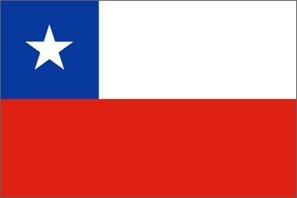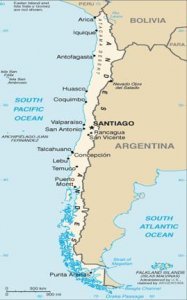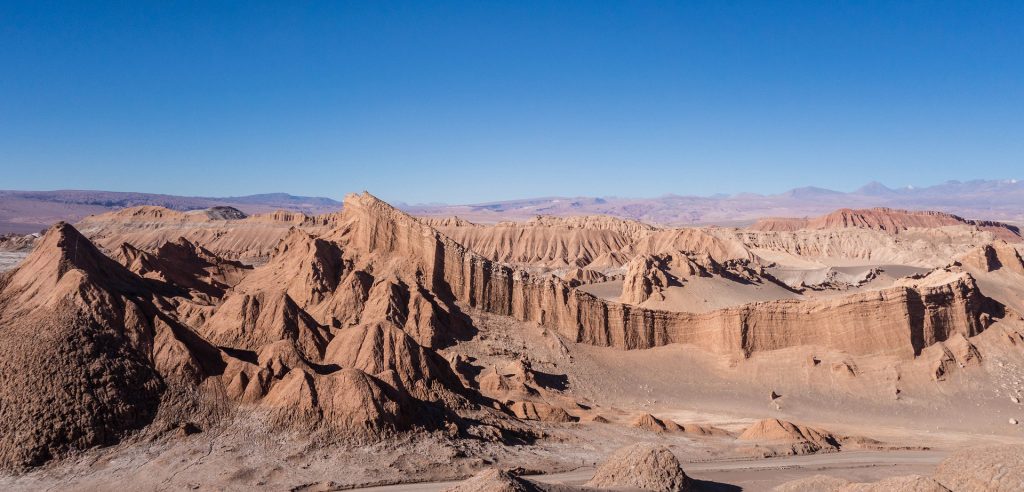
GEOGRAPHY
Chile is situated in South America, bounded by Peru, Bolivia, Argentina, the Antarctic and the Pacific Ocean. Home of the Andes mountain range, it is a thin ribbon of land, 2,610 miles long and nowhere more than 115 miles wide. Arica, near the northern border with Peru, is an excellent tourist center. It has good beaches and the famous San Marcos Cathedral. Chile’s central region and the islands feature the snow-capped peaks of the Andes, rolling green fields, vineyards and orange groves. The modern capital city, Santiago, has a good range of hotels to suit all tastes and pockets. Easter Island, west of the mainland, is famous for the Moai, gigantic stone figures found all over the island.
HISTORY

When the Spanish founded a colony in 1541 at Santiago, Chile was sparsely inhabited by the Araucanians. Although the Spanish controlled the whole Pacific coast north of Santiago (about half of what is now Chile), they were never able to conquer the land to the South from the Araucanians. Indians were enslaved and forced to work for the Spanish, who used Chile mainly for wheat and cattle production. When slavery was abolished in the 17th century, it was replaced by another exploitative system, sharecropping, that persisted until recently. Chile was one of the first countries to declare its independence from Spain. The colonists fought their mother country for eight bloody years, from 1810 to 1818, until victorious under the leadership of General Bernardo O’Higgins. By the middle of the 20th century, Chile had emerged as one of the most heavily industrialized countries in Latin America. It had one of the most comprehensive social welfare systems in the world and had a long tradition of political stability and respect for democracy.
In 1970, Salvador Allende, a socialist, was elected president. He instituted agrarian reform, nationalized the copper industry, utilities and some banks, and improved the lot of the poor by increasing wages and imposing price controls. In 1973, the military, led by General Agusto Pinochet, staged a coup and murdered Allende. Shortly after the coup, the military systematically rounded up its opponents and murdered or “disappeared” them. The Pinochet dictatorship was probably the bloodiest and most ruthless of the military regimes that dominated most South American countries during the 1970s and 1980s. The Catholic Church led the fight for human rights in Chile during the dictatorship, becoming in effect the only legal opposition. A plebiscite in 1988 rejected eight more years of military rule, and in 1989, elections were held which returned government to civilian rule. Pinochet continued to rule as head of the armed forces until recently. However, an amnesty was decreed for all political crimes committed by the military during the dictatorship, but a Chilean “Truth Commission” continues to investigate these crimes in order that the families of the disappeared will know how and when their loved ones died.
THE PEOPLE
The majority of Chile’s population is mestizo, a result of frequent intermarriage between early Spanish settlers and indigenous inhabitants. Many Chileans are also of German, Italian, Irish, British, or Yugoslav ancestry. Three small indigenous groups are still distinguishable — the Araucanians of central Chile (the largest and long the strongest group), the Changos of Northern Chile, and the Fuegians of Tierra del Fuego. Chile is predominantly urban, with more than a third of the total population concentrated in and around Santiago and Viña Del Mar. Nearly 90% of the people are, at least, nominally Roman Catholic.
SOCIAL CONVENTIONS
Handshaking is the customary form of greeting. Most Chileans use a double surname and only the first part should be used in addressing them. Normal courtesies should be observed when visiting local people.
It is very common to entertain at home and it is acceptable for invitees to give small presents as a token of thanks. Informal, conservative clothes are acceptable in most places but women should not wear shorts outside resort areas. Tipping: Restaurants and bars add 10 per cent to bill. However, waiters will expect a 10 per cent cash tip in addition.
LANGUAGES
The official language of Chile is Spanish. The accent of the Chileans is similar to the Latin Americans at the primary stage. They speak Spanish in their own way, style and mannerisms while talking. Despite the fact that the language has comparison with standard Spanish, yet their unique grammar, pronunciation, vocabulary, and manner of conversation is notable homogeneous. Southern Chile is improved with German tradition and spoken all over the country by 35,000 speakers. Therefore a small group of citizens speak German. Chileans also converse in some of the indigenous languages like Aymara and Mapudungun (language used by natives who lived in the areas of Itata and Tolten Rivers). Some native languages of the country that are currently extinct include Selknam, Kunza, Kakauhua and Diaguita.
The English language education is common among learners, higher professions and used for international business. The country’s language has its own pleasantness and fascination that is usually found in every regions of Chile. Currently, they improved their indigenous languages by method or techniques that are totally understandable by the citizens. Other existing languages in the country are Chilean sign language, Huilliche, Qawasqar, Yámana, Rapa Nui and Quechua.
GOVERNMENT
Executive power is held by the President as head of the Government, elected for a 6-year term. The bicameral Congress is responsible for legislation and comprises a 47-member Senate and a 120-member Chamber of Deputies, both elected by universal suffrage. The president is both the chief of state and head of government.
TIME ZONE
Continental Chile is situated geographically in UTC−05. Currently, Chile at a given time, uses 2 different UTC offsets. Since it practices daylight saving time, a total of 4 time zones are used. During winter, after the second Saturday of March and up to the second Saturday of October, except for Easter Island, it uses UTC-4. For Easter Island, its UTC-6. During summer, after the second Saturday of October and up to the second Saturday of March, daylight saving time is in effect, except for Easter Island, which uses UTC-3. In mainland Chile time is changed at 0:00 on a Saturday on the following Sunday and in Easter Island time is changed at 20:00 on a Saturday.
ELECTRICITY
220 volts AC, 50Hz. Lamp fittings are of the screw-type. Plug fittings in older buildings are of the two-pin round type, but some new buildings use the three-pin flat type.
CLIMATE
Chile’s climate ranges from hot and arid in the north to very cold in the far south. The central areas have a mild Mediterranean climate with a wet season (May to August). Beyond Puerto Montt in the south is one of the wettest and stormiest areas in the world.
Clothes to Wear:
Lightweight cottons and linens in northern and central areas. Rainwear is advised during rainy seasons. Medium weights and waterproofing are needed in the south.
LOGISTICAL
Entry and Exit Requirements:
U.S. citizens entering Chile must have a valid passport. Please ensure you have at least 6 months passport validity upon departure from Chile.
Visit the Embassy of Chile web site www.chile-usa.org for the most current visa information. Visitors should be aware of the severe Chilean restrictions on the importation of fruit, vegetables & agricultural products. Check the Ministry of Agriculture web site www.sag.gob.cl for current requirements. Americans traveling in Chile are encouraged to register with the U.S. Embassy through the State Department’s travel registration web site (https://travelregistration.state.gov/ibrs/ui/) so that they can obtain updated information on travel and security within Chile. Americans without Internet access may register directly with the U.S. Embassy. By registering, American citizens make it easier for the Embassy to contact them in case of emergency.
For travelers visiting Easter Island:
As of August 1st, 2018, those who travel to Easter Island as tourists may only stay for a maximum period of 30 days. The new norm establishes a series of requirements that must be presented to the Investigative Police of Chile (PDI) when boarding the island. In the first place, travelers must fill out the Unique Entry Form (Formulario Único de Ingreso-FUI), present the identity card or passport, the return ticket and the reservation in tourist accommodation authorized by Sernatur or letter of invitation from a person belonging to the Rapa Nui people, or another authorized person to reside in the island territory, which must be extended through the Provincial Governorate of Easter Island. The new law establishes who can stay on the island for more than 30 days: belonging to the Rapa Nui people and their families, current residents, hired workers or who carry out an independent economic activity on the island, public officials, researchers, authorities and pre-candidates and candidates registered in the electoral register, in accordance with current regulations. Latam Airlines highlighted that it is working closely with the Ministry of the Interior and Public Security in the implementation of this new law, which – as in other countries – aims to protect the ecological and cultural heritage of this special territory. In this sense, Latam recommended its passengers to arrive three hours in advance of their flight to comply with all the formalities.
Embassy Locations:
Embassy of the United States of America
Avenida Andres Bello 2800
Las Condes, Santiago
Tel: (56-2) 330-3000
Consular fax: (56-2) 330-3005
Canadian Embassy
Nueva Tajamar 481 – Piso 12
Torre Norte, Santiago
Tel: (56-2) 652-3800
Fax: (56-2) 652-3912
Open 8:30am-11:30pm, Mon-Fri
http://santiago.usembassy.gov/
http://www.canadainternational.gc.ca/chile-chili/
Health:
The ozone layer is especially thin at the bottom of the world. Travelers should take proper precautions to protect themselves from ultraviolet radiation.
Information on vaccinations and other health precautions, such as safe food and water precautions and insect bite protection, may be obtained from the Centers for Disease Control and Prevention’s (CDC) hotline for international travelers at 1-800-CDC-INFO (1-800-232-4636) or via the CDC website at http://wwwnc.cdc.gov/travel. For information about outbreaks of infectious diseases abroad consult the World Health Organization’s (WHO) web site at www.who.int/en. Further health information for travelers is available at www.who.int/countries/chl/en/.
Banks and Currency:
The Chilean Peso is the currency in Chiel; (CLP; symbol CH$) = 100 centavos. Notes are in denominations of CH$20,000, 10,000, 5,000, 2,000, 1,000 and 500. Coins are in denominations of CH$500, 100, 50, 10, 5 and 1.
Foreign exchange transactions can be conducted through commercial banks, casas de cambio, or authorised shops, restaurants, hotels and clubs. Casas de cambio are open daily 0900-1900 (Mon-Sat) and 0900-1400 (Sun).
Credit/debit cards (Visa, Diners Club, MasterCard and sometimes American Express) are widely accepted in towns and cities, where ATM’s are also largely available. Outside of the larger, more tourist-centred towns, currency exchange can be tricky.
The government does not regulate the market of foreign currency in Chile, making it possible to exchange money and traveller’s cheques at any casa de cambio at market-driven exchange rates. There may be some difficulty exchanging traveller’s cheques outside major towns. Traveller’s cheques in US dollars can offer a better exchange rate.
Banking are hours are Monday to Friday, 9am to 2pm.
Communication:
The company in charge of the postal service is Correos de Chile. Mailing is quite secure and taken seriously, however, somewhat slow. Post offices are open during the week from 9am – 6pm and on Saturdays from 9am – 12pm, and you can send certified letters at an additional cost. You can send packages of up to 66 lbs. through the main postal system.
In Chile, several companies offer fax, telex and telegraph services; these communication systems are very advanced and at reasonable prices.
There are many phone booths throughout the city, thus we recommend you buy a phone card or keep CH$100 peso coins at hand. Calling from the hotel room often has a surcharge depending on the Hotel. From Chile, international calls are cheap and work efficiently. Most commercial and shopping centers have international call centers where you can obtain information, make collect calls, or buy calling cards. Cellular phones are widely used and can be easily rented.
Chile has well developed data communications services. E-mail and Internet is widespread. Some hotels offer such services in their business centers. You can also check your e-mail and surf the Net in several Cyber cafes throughout the city.
Cell Phone Usage:
Please contact your cell phone provider to determine whether your contract includes coverage in the country you are visiting. Depending on your contract you may have to add international services and/or country specific services.
ENTERTAINMENT
Food and Drink:
Chile has a wide variety of foods, including seafood, beef, fresh fruit, and vegetables. A traditional Chilean meal is pastel de choclo , a “pie” made with corn, vegetables, chicken, and beef. This dish is usually served with ensalada chilena (Chilean salad). Another typical Chilean dish is cazuela de ave, a thick stew of chicken, potatoes, rice, green peppers, and, occasionally, onions. Humitas are a national favorite, and they come from the Amerindians who are native to Chile. Humitas are made with grated fresh corn, mixed into a paste with fried onions, basil, salt, and pepper. The mixture is then wrapped in cornhusks and cooked in boiling water.
Empanadas , little pies usually stuffed with beef, olives, and onions, are another favorite. A popular dish is bistec a lo pobre (“poor man’s steak”), which is steak topped with two fried eggs, and served with fried onions and French fries. Despite the name, poor Chileans cannot afford to eat this meal because beef is very expensive; this dish is actually eaten by wealthier people. Tomaticán (tomato and corn stew) is often served as a side dish with meat, chicken, or fish.
Mealtimes are an important part of family life. Families almost always eat together at home, only going to a restaurant on a special occasion. Mothers prepare a light breakfast of toast and milk for their children. Lunch is the biggest meal of the day, and two main dishes are often served. The first dish might be a salad with seafood. The other dish might be cazuela de ave , a thick stew of chicken, potatoes, rice, green peppers, and, occasionally, onions. Chancho en Piedra (Chili and Tomato Spread) is often served with bread as an accompaniment to meals, or may be eaten by students as a snack. In small towns, businesses close for almost three hours so people can go home and eat lunch with their families and take a siesta (nap). Dinner is usually one main dish. For dessert, Chileans eat fresh fruit, ice cream, or other desserts such as arroz con leche (rice pudding).
Restaurants range from snack bars to expensive restaurants. A favorite Chilean “fast food” meal is a completo, which is similar to a hot dog and typically accompanied with mustard, avocado, tomatoes, and mayonnaise. Ponche (Chilean punch) is a traditional and popular beverage.
Nightlife:
While many restaurants and hotels offer entertainment there are also a number of independent discos and nightclubs.
Shopping:
Chile is a country that is famous for being a blend of traditional cultures and modernity. This has helped the land excel in terms of modern developments and has also generated expertise in the field of traditional handicrafts and other forms of handmade works. Thus the market accommodates products that represent modernity as well as products that remind the Chile natives and foreign tourists about the traditional aspect of the land. Shopping at Chile is exciting and dynamic. This is chiefly because the country is modern and is associated with the best of the international markets. Chile houses the most diverse shopping malls that sell modern goods, and brand new gizmos.
On the other hand, the country also has a number of reputed local sellers and local markets that sell traditional handicrafts, furniture, jewelries, handmade sweaters, etc. All these traditional goods are available in the local markets at quite reasonable fares. The handicrafts reflect the true taste of the Andean lifestyle and culture. The accessibility within the country is commendable. This helps tourists go for extensive shopping in the most unconventional venues.
The most well known shopping destinations in Chile are located at Antofagasta city, Arica, Calama, Concepcion city, Copiapo city, Osorno and Punta Arenas to name a few. All these places are famous for housing the best of departmental stores, craftsmanship and water sports supplies. Thus Chile is a great place to shop. It caters to all kinds of needs and pays attention to the interests of local as well as foreign buyers.
BAGGAGE
Baggage rules for international and domestic air travel have changed much in recent years, differ from carrier to carrier and these days even may cover your on-board bags. Checking luggage may cost a separate fee or may be free depending on your personal status with the carrier. We therefore encourage you to read your ticket’s small print and/or contact your carrier for exact rules.
TIPPING
Normally about 10% in restaurants. It is rare to tip for taxies, unless they help you with your bags. Leave about 300 pesos per day for the hotel room cleaner, and give 300-500 pesos to a porter for carrying your luggage.
LAUNDRY
There are many places that do laundry, usually costing around $2.5 per 2lbs.
PHOTOS & VIDEOS
In some countries you must refrain from photographing sites such as Military bases and industrial installations. Also be aware of cultural sensitivities when taking pictures of or near churches and other religious sites. It is always courteous to ask for permission before taking photographs of people.
USE OF DRONES
The use of drones is being legislated by many countries. In some cases drones are already forbidden and their unauthorized use may carry severe penalties. If you plan to travel with a drone please contact the embassy or consulate of the country you wish to visit.
![SITA Canada Final_color [Converted]new_for_wp SITA Canada Final_color [Converted]new_for_wp](https://sitatourscanada.com/wp-content/uploads/2019/12/SITA-Canada-Final_color-Convertednew_for_wp.png)
